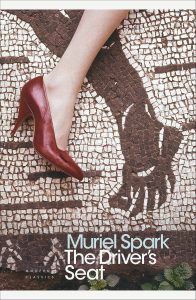THE DRIVER’S SEAT by Muriel Spark (BOOK REVIEW)
“’Too much self-control, which arises from fear and timidity, that’s what’s wrong with them. They’re cowards, most of them.’
“’Oh, I always believe that’, says Mrs Fiedke. ‘No doubt about it. The male sex.’”
Muriel Spark’s 1970 novel The Driver’s Seat is a grisly and unsettling masterpiece. In a mere hundred pages, Spark brutally takes apart the crime novel, and brilliantly dissects the changes in gender relations emerging in Europe following World War II to reveal their darker side. From the beginning of the novel, we are told that protagonist Lise, who is just leaving for a holiday in a European city, will be found dead the next morning from stab wounds with her wrists and ankles bound. Spark ratchets up the tension to almost unbearable levels, as Lise’s reckless exploration of freedom revels itself to be something more sinister as she edges closer to her tragic fate. The Driver’s Seat is a chilling exploration of madness, desire and obsession, all the more disturbing for its steadfast refusal to offer any comforting answers. Like Spark’s The Hothouse By The East River (1973), it is a disturbing and alluring masterpiece. The Driver’s Seat is, however, one of those books that one cannot talk about without revealing the plot, so those wary of spoilers should stop here, and come back once they’ve read the book.
 Lise is in desperate need of a holiday, after working in the same office for sixteen years. She buys a new garish dress and departs for an unnamed destination abroad, hoping to meet the man of her dreams for sex and adventure. However before her plane leaves, the reader is informed that Lise will be found the next morning stabbed to death in a park. As we witness Lise’s interactions with the people she meets, and she seeks out more and more dangerous situations, it becomes increasingly clear that she is a woman on the verge of a nervous breakdown, and that her journey of self-discovery is quickly turning into a relentless quest for self-destruction. Spark dials up the tension with each of Lise’s successive encounters with dangerous, predatory men, as the reader knows her inevitable fate is crawling closer and closer. By the end of the book, we discover the Lise has essentially orchestrated her own brutal murder.
Lise is in desperate need of a holiday, after working in the same office for sixteen years. She buys a new garish dress and departs for an unnamed destination abroad, hoping to meet the man of her dreams for sex and adventure. However before her plane leaves, the reader is informed that Lise will be found the next morning stabbed to death in a park. As we witness Lise’s interactions with the people she meets, and she seeks out more and more dangerous situations, it becomes increasingly clear that she is a woman on the verge of a nervous breakdown, and that her journey of self-discovery is quickly turning into a relentless quest for self-destruction. Spark dials up the tension with each of Lise’s successive encounters with dangerous, predatory men, as the reader knows her inevitable fate is crawling closer and closer. By the end of the book, we discover the Lise has essentially orchestrated her own brutal murder.
The Driver’s Seat title relates to the central question of the book – who is in control? – and the unsettling answer that Lise has responded to the pressures and the freedoms opened up to women in the modern age by choosing her own bloody demise. Lise is the tragic female victim of the serial killer inverted – she knowingly stalks her killer out of lust for the kind of destruction he can bring her. Spark makes the reader deeply uncomfortable by taking the agency and placing it in Lise’s hands, only for the story to end up in the same place. On the surface, Lise is the very image of the post-war, post-60s liberated woman. She lives by herself, supports herself by working in an office, and is free to explore her sexuality by trying on the role of temptress for the holidays and seeking romantic encounters in a foreign city. However, Spark cunningly intimates throughout that this freedom has its unacknowledged dark side. Lise is approaching her mid-30s and is still unmarried, in a society that has loosened some of the restrictions on women but still expects them to ultimately settle down and nurture the family. All of Lise’s interactions with male characters, be it the handsome killer trying to reform himself that she convinces to murder her, the sleazy, macrobiotic-obsessed cult leader who tries to pick her up on the plane, or the proprietor of a garage who tries to rape her, are fraught with danger, and reveal that the sexual freedoms opened up by the sixties and free love for men is still delineated by the threat of sexual violence for women. For Lise and other women like her, the advances in women’s rights have only progressed far enough to reveal the brutal restrictions that are still placed on their lives.
Lise is a protagonist as alienated as any character in a Philip K. Dick book, and her ultimate response to the stresses that constrict her life is to vicariously seek her own destruction. As such she is a strikingly postmodern heroine. Throughout the book, Spark paints her as the dangerous femme fatale, utterly in control of her situation. Her first words to the man who kills her are, “You look like Red Riding-Hood’s grandmother. Do you want to eat me up?”, a statement that so rattles him he abandons his seat next to her in fear. The reversal of the male perpetrator of violence and the female victim is something that recurs throughout the novel, to disorienting and disturbing effect. Her description of men as “cowards” takes on an especially sinister tone once we realise what she has planned for herself, and this is contrasted by the widow Mrs Fiedke’s response, in which she laments advances in women’s rights because it gives equality to the men rather than the other way round. The novel shows a world in which the traditional gender roles of man and woman are beginning to be destabilised, but again Lise enters this space where there is potential for revolution, equality and exploration of new rules only to bump up against more restrictive boundaries of a still-inherently conservative society.
Like the protagonist of Spark’s debut novel The Comforters (1957), The Driver’s Seat implies that Lise may have some awareness of her own fictional nature. Abandoning the book she bought to read on the plane, Lise says:
“You can have the book as well; it’s a whydunit in q-sharp major and it has a message: never talk to the sort of girls that you wouldn’t leave lying about in your drawing-room for the servants to pick up.”
This could also serve as a cynical description of The Driver’s Seat itself, with Lise casting herself as the dangerous femme fatale of her own story. It’s also indicative of the dark humour that Spark brings to proceedings throughout. For all its darkness and discomfort, The Driver’s Seat is an absolute joy to read, crackling with Spark’s wild wit and deft characterisation. The novel’s seductive surface is the perfect counterpoint to its dark and disturbing themes, allowing it to sink its claws deep into the reader. It confirms Spark as a uniquely powerful and perceptive writer.

